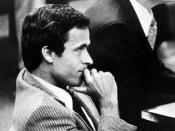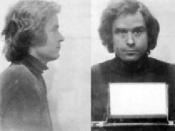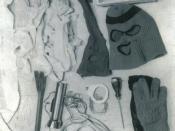"I'm the most cold-blooded sonofabitch you'll ever meet." - Ted Bundy Men envied his grace and charm. Women admired his stunning good looks and polite manner. In the 42 years of his life, Ted Bundy acquired many names and faces. To his political friends he was a brilliant young man on his way up to the top in the legal system, maybe even a possible senator one day. To his mother, he was the ideal son, doing very well academically. His outside image however was nothing but a lie, the largest of which being a lover of women.
In the times of his birth it was an embarrassment to have a child out of wedlock. For this reason Eleanor Louise Cowell (a native of Philadelphia) was sent to a home for unwed mothers in Vermont. It was there that she gave birth to her child on November 24, 1946. Ted's father, Lloyd Marshall, was an Air Force veteran and said to be away at the time of his birth.
He remained rather unknown to Ted throughout his entire life. Right after his birth, Eleanor moved back to Philadelphia with her parents and for the next two months the family debated over whether to put Ted up for adoption or not. Eventually they came to the conclusion that they would just tell people that her parents adopted him and claim that he was not her child. In doing so they were hoping to save Ted and her any harsh criticism and judgment.
For these reasons, Ted grew up believing that his grandparents were his parents and his legitimate mother was just an older sister. At one point in his childhood, however, when arguing with a relative they let out that he was a bastard. To make matters worse they even showed him his birth certificate to prove that it was not a lie. Ted, however, responded as though it did not bother him in the least. It was from this point though that it is believed Ted knew of who his parents really were.
Ted's home life is rather debatable. If Ted was asked he would do nothing, but brag about his grandfather and speak highly of him. He could sit and just recall nostalgic memories from his boyhood of camping and fishing trips. Louise also agreed with these accounts of her father being an amiable man. The controversy appears when other relatives' opinions were asked. They say him as an ill-tempered man. They stated that he was verbally abusive and at times even physically abusive to his wife. His grandmother was not exactly a stable person either. She had to fight her fits of depression and eventually became so bad she would not leave her own house.
In an attempt to save Ted anymore embarrassment during his childhood, Louise and him moved to Tacoma Washington and changed their last names. Louise lived with relatives, but pretended as though she was widow. It was here that she met and married Johnnie Culpepper Bundy, whose last name Ted would carry around for the rest of his life. The couple ended up having four other children, who Ted often babysat after school. In junior high Ted was bullied and teased very often. Through all of this however he did maintain excellent grades. People who looked back on him when he was in high school even remember him as a more popular fellow. As hard as people thought though, they could never remember him dating somebody. His interests were always somewhere else, such as skiing or politics.
When Ted graduated from high school in 1965 and began college at the University of Washington, he met Stephanie Brooks. She became his everything, including his first love. She liked Ted a lot also but believed he had no direction in his life so eventually broke it off with him. He never seemed to get passed this break up because he was so infatuated with her. He changed rather drastically and became extremely motivated and determined to prove himself to the world and, more importantly, Stephanie.
Ted enrolled himself once again in the University of Washington, but this time for psychology. It was during this time that he met Meg Anders, who he would become involved with for the next several years. His life began to look up and he was beginning to accomplish many things. At one point when he was on a business trip he met up with Stephanie once again. His plan had worked. She was so amazed at the person he had turned into that she fell in love with him once again. This time however, Ted broke her heart, which to him was the ultimate revenge. Stephanie never heard from him again.
The madness began December 6, 1973. Kathy Devine, a 15 year old girl, was found in McKenney Park, Washington. She had been strangled, sodomized, and then her throat was cut. Soon after this, the discovery of another girl, named Joni Lenz, was found. At the scenes, however, there was very little evidence found. Next came Lynda Ann Healy's peculiar case. When she didn't show up to work or dinner people became suspicious. The condition they found her room in was even more of a puzzle, because it did not really indicate to foul play. There was blood on her pillow, which was missing the pillow case, on the mattress, and on the collar of her nightgown which had been hung in her closet. Two of her housemates also said that her bed was made different then usual. Missing from the room other than the pillowcase was the top bed sheet, some clothing, and her book bag. Investigators, however, assumed that she would eventually turn up, but she never did.
During the next spring and summer, seven more students disappeared. Similarities were beginning to be noticed in all of the cases. The girls that were disappearing were white, thing, single, wearing slacks, and had long hair that was parted in the middle when they disappeared in the evenings. Also when police interviewed people that were around at the times, people were stating that they saw a man with a cast on struggling with books or in a VW bug that would not start asking young ladies for help.
Eventually in August of 1974 the missing girl's remains were found in Lake Sammamish State Park, in Washington. Two of the bodies that were identified were Janice Ott and Denise Naslund. The last time Ott was seen alive was on July 14. A couple who had been picnicking remembered seeing her approached by a man with a cast asking for help loading his boat. Denise Naslund was also last seen on July 14. She was spending the day with her friends and boyfriend when she went towards the restrooms. She was never seen again, although witnesses do remember watching her walk away with a man who was wearing a cast and going around asking women for help with his sailboat. In Utah, the police chief's daughter, Melissa Smith was also a 17-year-old victim. On October 18, 1974 she was missing until 9 days later when she was foundâ¦strangled, sodomized, and raped. On Halloween, 17-year-old Laura Aime, was yet another disappearing teen. Thanksgiving Day however she was found just like the others, raped and sodomized. This time though she had been beaten on the head and face with a crowbar. This time it was also believed that the body was killed somewhere else due to the lack of blood in the area. As usual however, there was no physical evidence other than the body.
The Utah police were now having their attention called to the similarities between their murders and the ones from Washington State and Oregon. Evidence was building bit by bit, but still no where near leading them to a specific person. They also came up with a drawing of a could be killer that seemed to be identifying himself to people as "Ted." A close of Meg Anders saw the police sketch and began to urge her friend to go to the police with Ted's name. While Anders hesitated for a bit, she did eventually go, but nonetheless his name was filed away and forgotten until years later. It wasn't until November 8th, 1974, that police got the break that they had been waiting for in the case.
In a Utah mall a man claiming to be mall security approached an 18-year-old woman by the name of Carol DaRonch. The man proceeded to tell her that her car had been broken into and that they would need to go out to it and check to see if anything was stolen. Once there and she reported that everything looked fine the man began insisting that they go to the police station together to file a complaint and ID the supposed criminal. DaRonch became suspicious when "Officer Roseland" led her to a beige VW bug to take her to the station in. In response to her fear she asked if he had any identification and he in turn flashed her gold badge quick. Satisfied she got into the car and they drove off. It wasn't long, however, before she realized they were not heading to a station at all and that in actuality they were going in the opposite direction. Next thing DaRonch knew, "Officer Roseland" had pulled off to the side of the road and pulled out a set of handcuffs and put them on her. Luckily for her though the passenger door opened and she fell out of it. At this point Ted got out of the car and went to her side with a crowbar raised above his head. Thinking quickly DaRonch kicked Ted and managed to break free. Down the road a car was driving and stopped when she ran out in the street and immediately took her to the police station. From this they managed to get a description of the man, a description of the car, and the blood type O off of her coat.
This was the same night that Debby Kent disappeared. Jean Graham the director of the Viewmont High School play remembers a man coming backstage and attempting to talk to her, but she was so busy she just brushed him off. Meanwhile Debby Kent was out in the audience with her family. She was leaving early to go pick her brother up at the bowling alley and said she would be back to pick her parents up shortly. She never did this though because sadly, Kent never even made it to pick up her brother, or to her car for that matter. In the parking lot, however, the cops did find a small handcuff key, the same kind used to free DaRonch from her handcuffs.
On January 12, 1975, yet another female went missing. Caryn Campbell was vacationing with her fiancé and his children in Colorado. While relaxing in the lobby with everyone in the evening the realized she forgot a magazine in their room and went to go get it. Waiting for awhile her fiancé decided to go check on her to find she never even made it back to the room. Every room in the hotel was searched but there was no sign of her. A little less then a month later her nude body was found laying a short distance from the road by recreational workers. Just like the victims in Washington, Utah, and Oregon she had suffered many blows to the head and little evidence was found around the body. A few months after Campbell's body was found Brenda Ball's body was discovered in the Taylor Mountains. Ball was one of the seven women who had disappeared earlier in the summer. Police decided to do a search of the mountains and found Susan Rancourt, another disappearance from the summer, Lynda Ann Healy, and another body that was not identified. The Taylor Mountains was now the burial sight for the madman known as "Ted." Five more women were found dead in Colorado with the same circumstances.
On August 16th, 1975, Ted Bundy perhaps made his one single mistake. While driving through a neighborhood, a police officer that knew the area well recognized his car as an unusual one. Being a bit suspicious he decided to follow Bundy. Instead of keeping his cool, Bundy began to speed away going through two stop signs and driving recklessly. The cop was going about his regular business checking is license and registration when it was noticed that his passenger seat was missing. Asking Bundy's permission he searched the vehicle to find a crowbar, ski mask, rope, handcuffs, wire, and an ice pick. Bundy was immediately arrested for suspicion of burglary.
After arresting him, the police began to notice the similarities between him and the man who attached Carol DaRonch. The handcuff's were the same make and brand, the crowbar was similar to the one she was threatened with, and the car was similar to the one she had described. They were also beginning to suspect that he was the one responsible for Melissa Smith, Laura Aime, and Debby Kent, but knew they needed much more evidence to convict him of anything. They called Carol DaRonch and Jean Graham in who immediately picked him out of a line up of men. Right after this they began a full-blown investigation on Ted Bundy.
One of the first people questions about Bundy was Meg Anders. She said that on the nights of the murders she could not account for him. Anders also told the police about how he would often sleep all day and then is out all night, but she had no idea where he would go. She even talked about how his interest in sex had begun to change. It had begun to decrease, and the times when he was interested he would pressure her into bondage. If she told him she did not want to participate in that style, he would grow upset and irritated with her. She also offered the police information on how Bundy had plaster of Paris to make casts in his room and kept a hatchet in his car. One of the last bits of information she offered the police was that in July he had gone to Lake Sammamish to water ski. A week after he had went there was when Janice Ott and Denise Naslund were reported missing.
As the police continued their investigations they found more and more bits of evidence. More and more eyewitnesses were coming forward and recognizing him of being at Lake Sammamish Park. An old friend of his stated how he had seen a pair of pantyhose in the glove compartment of Bundy's car and that he spent a lot of time in the Taylor Mountains. Another friend had told of seeing Bundy wearing a cast, yet there was no medical records stating any reason for it. The police even found gas purchased on credit cards in cities where the victims were missing.
Finally on February 23, 1976, Ted Bundy was put on trial for the kidnapping of Carol DaRonch. He sat in the courtroom cool and collected, because he did not think there was any hard evidence to convict him. He stated that he had never even seen Carol DaRonch, although he did not have any alibi to confirm where he was the day of the attack. The judge took the weekend to review the case and in returning stated that he saw him as being guilty beyond a reasonable doubt of aggravated kidnapping. He was sentenced to one to fifteen years in prison with the possibility of parole.
While Bundy was in jail serving this sentence, investigators continued searching for evidence to connect him to the murders of Caryn Campbell and Melissa Smith. The police soon found hairs in his car similar to that of Campbell and Smith and found that Campbell's skull bore the marks made by a blunt instrument that matched the crowbar taken from his car. It was now that the Colorado police filed charges of murder against him for Caryn Campbell's death.
During the preparation for this case Bundy grew very unhappy with his counsel and decided that he could do a better job representing himself. He was even granted permission to leave the jail sometimes to use the courthouse library in Aspen in order to research. On June 7th, while he was on one of his many trips he jumped from an open window. He did not stand out among normal people though because while at the courthouse library he did not have to where any leg irons or handcuffs. The Aspen police quickly set up roadblocks, which Bundy expected so he already knew to stay within the city limits. He lived off of food he stole from local cabins and nearby campers. He knew what he really needed in order to escape however was a car. He thought he had his the jackpot when he found a car with the keys left in it. However, after his six days of freedom he was caught in the stolen vehicle and recaptured.
About seven months later, Bundy escaped again. The only exception was that this time it worked. On October 30th, he crawled into the ceiling of the Garfield County Jailand and crawled until he found another opening which led into one of the jailer's apartments. He waited until he knew it was empty and then just casually walked out the door to his freedom. His escape went unnoticed until the next afternoon, which was more then fifteen hours later, when Bundy was well on his way to Chicago. By mid January of 1978 there was no more Ted Bundy. He was no Chris Hagen, a man living in a one-room apartment in Tallahassee, Florida. He spent his time sitting in on classes and lectures at Florida State University or watching shows on his stolen television in his apartment. Almost everything he had was stolen or purchased on stolen credit cards. While he seemed to have everything, what he was still missing was companionship.
Becoming too much for him he struck again on January 14th at the Chi Omega House. Nita Neary was dropped off outside of the house by her boyfriend to find the door standing wide open. When she walked inside she heard footsteps running around on the floor above coming closer to the staircase. She hid herself in a doorway and watched a masked man run holding a log with cloth around it down the steps and out the door. Her immediate thought was they had been robbed. She ran upstairs to her wake her roommate and relayed her story to her. Not knowing what to do they decided to go wake their housemother and tell her. As they went out into the hallway they say another roommate, Karen Chandler, stumbling down the hall with her head soaked in blood. Another roommate, Kathy Klein, was found alive but in horrible conditions also. Two more girls were later found in lying in their beds dead. Lisa Levy had been beaten on the head with a log, raped, and strangled. Once examining her even more they found bite marks on her buttocks and one of her nipples had practically been severed from her body. Margaret Bowman showed similar characteristics, with the exception of the bite marks. She had been strangled with a pair of panty hose and her skull had been splintered with a portion of her brain showing. Both girls showed no sign of struggle though. The girls who did survive had no memory of the attacks.
Later that night, less than a mile from the Chi Omega House, a woman was awaken by loud banging noises coming from the apartment next to hers. The noises continued and she listened harder and believed she heard her neighbor, Cheryl Thompson moaning and called over to her apartment. When no one answered she called the police who responded immediately since they were only right up the street. When they entered Thompson's room she was sitting on the edge of her bed, her face just beginning to swell from the beating on her head. At the foot of her bed the police discovered a mask.
The investigators worked hard on the evidence that was left behind. They had found a blood type of the attacker, sperm samples, and fingerprint smudges. A majority of what was tested turned out to be inconclusive though. The only hard evidence they obtained was hair from the mask and the teeth marks left on Levy's body.
Ted Bundy made his last attack on February 9th, 1978. The police received a phone call from the parents of Kimberly Leach, a twelve-year-old girl. They were distressed because she had disappeared from her school grounds. The last person to see her was her friend Priscilla Blakney, who stated she saw her get into the car of a stranger. She, however, could not remember the driver of the vehicle. Leach's body was found weeks later, but was in a state of such decomposition that there was very little information available.
A couple days before the disappearance of Leach, however a man in a white van had approached another young girl by the name of Leslie Parmenter, who was waiting for her brother to pick her up. The man claimed he was from the fire department, which she found odd, because he was in regular clothes. Her father, the Chief of Detectives for the Jacksonville Police Department, had warned her many times not to talk to strangers. She was relieved when her brother showed up and told him the story. Her brother followed the man and wrote down his license plate number and gave it to his father.
Their father had the plates checked out and went to visit the owner of them to find out the man's plates had been stolen a few days earlier. He also later found out that the van his kids had seen was also stolen. When he took his children to the station to look at pictures, they pointed to the picture of Ted Bundy.
By this time, Ted Bundy had discarded the van and found himself another VW Bug. His recapture sounds just like de ja vu. As he was driving through a neighborhood a police officer noticed his car as one that did not belong to the area. When the cop ran a check on his plates he found that they were stolen. He decided to follow, and as he did Bundy sped off. Out of nowhere he just stopped again. The officer yelled for him to get out and lay on the ground and Bundy obliged. As the officer was getting ready to handcuff him, he rolled over and began to put up a fight and got up and ran. The officer fired his weapon and Bundy dropped as though he was shot. The officer approached him and once again Bundy began to fight back. He was quickly over taken by the officer though, and taken to the police station.
Over the months after he was arrested, investigators were able to collect important evidence to use in the Leach case. The van that was stolen had been found and Bundy was spotted driving it by three people on the day that Leach had disappeared. Forensic tests on the van showed fibers of Bundy's clothes on the seats. Leach's blood type was also on the van's carpet and his semen and blood type had been found on her underwear when her body had been recovered. Another item of evidence found as an impression of Bundy's shoe found near Leach's body. Feeling confident the police were now ready to take him to trial for the murder of Kimberly Leach, along with the Chi Omega murders and attacks.
The Chi Omega murder trial took place first. Bundy decided to represent himself once again. The majority of his jurors where African American (for what reason I'm not sure). The two major events that swayed the jury in the trial was Nita Neary's testimony of what she had witnessed and the testimony of an odontologist (bite marks). During her testimony Nita Neary actually pointed at Bundy stating he was the one she had seen. Dr. Souviron, the odontologist, showed the jury pictures of the bite marks and uniqueness of the indentations left behind them a long with a full-scale photo of Bundy's teeth. It proved to show a perfect match. The photos were actually the biggest piece of evidence the prosecution had. The jury deliberated for almost seven hours and came back with a guilty verdict. He was also found guilty of the attacks and the murder of Kimberly Leach. On July 31st he was sentenced to the electric chair. He attempted to appeal many times, but it never worked. He eventually confessed to the murders of 28 women, but many believe the number of deaths is thought to be much higher. No one will ever really know though how many women fell victim to Ted Bundy though. He took that number to the grave with him on January 24, 1989 when he was finally executed.
When reviewing the serial killer handout I took notice to a couple. Ted Bundy definitely fits under the classification of a serial killer if not an organized serial killer. Ted Bundy was highly intelligent, the oldest of all the children, and very manly and masculine. He was a sociable person that was liked by many. Bundy was sexually capable and lived with his girlfriend Meg Anders who would speak of his constant travels. It was also said that he received harsh discipline when he was young (even though he did not admit to it himself). Whenever he was captured and in jail he was a model inmate. I say a serial killer because he seemed to have a specific kind. He would go after women with long hair parted in the middle, wearing slacks in the evening. I also believe the MO could fit him. I say this because it seems as though the MO is just about doing things the same or having similarities in the cases. The way that he persuaded the females, the attacks, and what was left behind was pretty much always the same that the police could put a link between the murders easily.
I learned from Ted Bundy that you really can not judge a book by its cover. On the outside this man was a handsome, intelligent, charming person. He hypnotized most that encountered him. Then once you searched a little bit deeper you found the enraged, bondage craving, madmen that for a short while was known only as Ted. The people that encountered this side of him were never seen again. I am impressed though because he kept his dark side hidden from many of the people close to him, including his own family. You would think that if a person was going out and killing there would be some sort of evidence that someone you lived with would pick up on it, but Meg Anders never suspected him.
I have mixed feeling about our criminal justice system. I find it hard to believe that it took so long for him to be found. Then when they let him leave the jail to go to the courthouse library I was shocked. When I got over that fact I was like okay, but he was kept under supervision or tied down. That was not the case though. They would let him put on civilian clothes and keep the handcuffs and leg irons off of him. Now that just seemed absurd. Even if you are the model inmate you still should not be given that much freedom. It just seemed like too much. After he escaped once he should not even been aloud to go to the library anymore. He may not have escaped again that way, but I still don't agree with the fact that they let him go after what had happened. Then when he did escape again it took almost a whole day to even realize he was gone. Why did it take that long? Should it have not been noticed sooner? Once we hit the actual trials I also have mixed feelings. I did not agree with Nita Neary's testimony at all. In everything that I read or saw where she told her story she spoke of the man with a mask showing nothing but his eyes running down the dark stairway. If that is the case how can she positively identify Ted Bundy in the courtroom? All she would have been able to identify is maybe the shape of his body, like his build. He was sitting though. In my opinion a person does not usually give off the same look when they are sitting as they normally do when they are standing. He could have been a lot shorter then what she identified him as originally, but the jury would never have known that. So now we are back to only being able to identify him by his face. In her stories though, all she saw was a mask. I feel as though maybe there was a lot of people around her pressuring her saying that is the man your testimony means a lot and so she just went with it. Identifying a man like that in front of a jury is going to send a definite message to the jury. It is different to describe a man that they then have to draw in their minds and compare to the defendant then sitting there and actually pointing to them. That gives the jury an immediate impression. It may not sound like much, because the bite marks still definitely led to Ted Bundy, but the fact that her testimony was a big part in the conviction just made me wonder, "Why didn't anyone else pick up on this?" Sources Cited A&E Biography Video: Ted Bundy: The Mind of a Killer.
Bell, Rachael and Marilyn Bardsley. Ted Bundy. 22 October 2002. The Crime Library. .
Michaud, Stephen G. and Hugh Aynesworth, Ted Bundy: Conversations with a Killer. Authorlink Press 2000.





